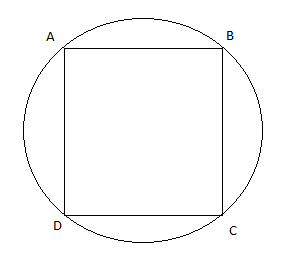Answer
414.9k+ views
Hint: For the above question, we will have to know about a cyclic quadrilateral. As the name of a cyclic quadrilateral suggests, it’s a quadrilateral which is inscribed inside a circle. All of its vertices lie on that single circle. We will use the property of a cyclic quadrilateral that the sum of each pair of opposite angles is 180 degrees \[\left( {{180}^{\circ }} \right)\].
Complete step-by-step answer:
We have been given a cyclic quadrilateral ABCD and asked to find the value of the expression as follows:
\[\cos \left( {{180}^{\circ }}+A \right)+\cos \left( {{180}^{\circ }}-B \right)+\cos \left( {{180}^{\circ }}-C \right)-\sin \left( {{90}^{\circ }}-D \right)\]

Now as we know that the sum of each pair of opposite angles in a cyclic quadrilateral is equal to \[{{180}^{\circ }}\].
\[\begin{align}
& \Rightarrow A+C={{180}^{\circ }} \\
& \Rightarrow A={{180}^{\circ }}-C....(1) \\
\end{align}\]
Also,
\[\begin{align}
& \Rightarrow B+D={{180}^{\circ }} \\
& \Rightarrow D={{180}^{\circ }}-B....(2) \\
\end{align}\]
Now,
\[\cos \left( {{180}^{\circ }}+A \right)+\cos \left( {{180}^{\circ }}-B \right)+\cos \left( {{180}^{\circ }}-C \right)-\sin \left( {{90}^{\circ }}-D \right)\]
Since we know that \[\cos \left( {{180}^{\circ }}\pm \theta \right)=-\cos \theta \] and \[\sin \left( {{90}^{\circ }}-\theta \right)=\cos \theta \],
\[\Rightarrow -\cos A-\cos B+\cos \left( {{180}^{\circ }}-C \right)-\cos D\]
On substituting the value of \[\left( {{180}^{\circ }}-C \right)=A\] and \[\left( {{180}^{\circ }}-B \right)=D\] in the above expression, we get as follows:
Since \[\cos \left( {{180}^{\circ }}-\theta \right)=-\cos \theta \],
\[\begin{align}
& \Rightarrow -\cos A-\cos B+\cos A-\cos \left( {{180}^{\circ }}-B \right) \\
& \Rightarrow -\cos A-\cos B+\cos A-\left( -\cos B \right) \\
\end{align}\]
On rearranging the terms, we get as follows:
\[\begin{align}
& \Rightarrow -\cos A+\cos A-\cos B+\cos B \\
& \Rightarrow 0 \\
\end{align}\]
Hence the value of the given expression is 0.
Therefore, the correct answer of the question is option B.
Note: Be careful while using the trigonometric identity like \[\cos \left( {{180}^{\circ }}-\theta \right)=-\cos \theta \] and also take care of the sign while calculating. In the given question, we assumed that B is less than equal to 90 degrees as the formula \[\sin \left( {{90}^{\circ }}-\theta \right)=\sin \theta \] is valid for \[\theta \le {{90}^{\circ }}\]. Also, remember the fact that the circle on which the cyclic quadrilateral lies is called the circumcircle or circumscribed circle.
Complete step-by-step answer:
We have been given a cyclic quadrilateral ABCD and asked to find the value of the expression as follows:
\[\cos \left( {{180}^{\circ }}+A \right)+\cos \left( {{180}^{\circ }}-B \right)+\cos \left( {{180}^{\circ }}-C \right)-\sin \left( {{90}^{\circ }}-D \right)\]

Now as we know that the sum of each pair of opposite angles in a cyclic quadrilateral is equal to \[{{180}^{\circ }}\].
\[\begin{align}
& \Rightarrow A+C={{180}^{\circ }} \\
& \Rightarrow A={{180}^{\circ }}-C....(1) \\
\end{align}\]
Also,
\[\begin{align}
& \Rightarrow B+D={{180}^{\circ }} \\
& \Rightarrow D={{180}^{\circ }}-B....(2) \\
\end{align}\]
Now,
\[\cos \left( {{180}^{\circ }}+A \right)+\cos \left( {{180}^{\circ }}-B \right)+\cos \left( {{180}^{\circ }}-C \right)-\sin \left( {{90}^{\circ }}-D \right)\]
Since we know that \[\cos \left( {{180}^{\circ }}\pm \theta \right)=-\cos \theta \] and \[\sin \left( {{90}^{\circ }}-\theta \right)=\cos \theta \],
\[\Rightarrow -\cos A-\cos B+\cos \left( {{180}^{\circ }}-C \right)-\cos D\]
On substituting the value of \[\left( {{180}^{\circ }}-C \right)=A\] and \[\left( {{180}^{\circ }}-B \right)=D\] in the above expression, we get as follows:
Since \[\cos \left( {{180}^{\circ }}-\theta \right)=-\cos \theta \],
\[\begin{align}
& \Rightarrow -\cos A-\cos B+\cos A-\cos \left( {{180}^{\circ }}-B \right) \\
& \Rightarrow -\cos A-\cos B+\cos A-\left( -\cos B \right) \\
\end{align}\]
On rearranging the terms, we get as follows:
\[\begin{align}
& \Rightarrow -\cos A+\cos A-\cos B+\cos B \\
& \Rightarrow 0 \\
\end{align}\]
Hence the value of the given expression is 0.
Therefore, the correct answer of the question is option B.
Note: Be careful while using the trigonometric identity like \[\cos \left( {{180}^{\circ }}-\theta \right)=-\cos \theta \] and also take care of the sign while calculating. In the given question, we assumed that B is less than equal to 90 degrees as the formula \[\sin \left( {{90}^{\circ }}-\theta \right)=\sin \theta \] is valid for \[\theta \le {{90}^{\circ }}\]. Also, remember the fact that the circle on which the cyclic quadrilateral lies is called the circumcircle or circumscribed circle.
Recently Updated Pages
The branch of science which deals with nature and natural class 10 physics CBSE

The Equation xxx + 2 is Satisfied when x is Equal to Class 10 Maths

Define absolute refractive index of a medium

Find out what do the algal bloom and redtides sign class 10 biology CBSE

Prove that the function fleft x right xn is continuous class 12 maths CBSE

Find the values of other five trigonometric functions class 10 maths CBSE

Trending doubts
Difference between Prokaryotic cell and Eukaryotic class 11 biology CBSE

Difference Between Plant Cell and Animal Cell

Fill the blanks with the suitable prepositions 1 The class 9 english CBSE

Change the following sentences into negative and interrogative class 10 english CBSE

Give 10 examples for herbs , shrubs , climbers , creepers

What organs are located on the left side of your body class 11 biology CBSE

Write an application to the principal requesting five class 10 english CBSE

What is the type of food and mode of feeding of the class 11 biology CBSE

Name 10 Living and Non living things class 9 biology CBSE



